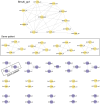This is a preprint.
Harnessing the diversity of Burkholderia spp. prophages for therapeutic potential
- PMID: 38328162
- PMCID: PMC10849711
- DOI: 10.1101/2024.01.24.577087
Harnessing the diversity of Burkholderia spp. prophages for therapeutic potential
Update in
-
Harnessing the Diversity of Burkholderia spp. Prophages for Therapeutic Potential.Cells. 2024 Feb 29;13(5):428. doi: 10.3390/cells13050428. Cells. 2024. PMID: 38474392 Free PMC article.
Abstract
Burkholderia spp. are often resistant to antibiotics, and infections with these organisms are difficult to treat. A potential alternative treatment for Burkholderia spp. infections is bacteriophage (phage) therapy; however, it can be difficult to locate phages that target these bacteria. Prophages incorporated into the bacterial genome have been identified within Burkholderia spp. and may represent a source of useful phages for therapy. Here we investigate whether prophages within Burkholderia spp. clinical isolates can kill conspecific and heterospecific isolates. Thirty-two Burkholderia spp. isolates were induced for prophage release, and harvested prophages were tested for lytic activity against the same 32 isolates. Lytic phages were passaged and their host ranges were determined, resulting in four unique phages of prophage origin that showed different ranges of lytic activity. We also analyzed the prophage content of 35 Burkholderia spp. clinical isolate genomes, and identified several prophages present in the genomes of multiple isolates of the same species. Finally, we observed that B. cenocepacia isolates were more phage-susceptible than Burkholderia multivorans isolates. Overall, our findings suggest that prophages present within Burkholderia spp. genomes are a potentially useful starting point for the isolation and development of novel phages for use in phage therapy.
Keywords: Burkholderia; antibiotic resistance; phage therapy; prophage.
Figures





Similar articles
-
Harnessing the Diversity of Burkholderia spp. Prophages for Therapeutic Potential.Cells. 2024 Feb 29;13(5):428. doi: 10.3390/cells13050428. Cells. 2024. PMID: 38474392 Free PMC article.
-
Genetic and phenotypic diversity in Burkholderia: contributions by prophage and phage-like elements.BMC Microbiol. 2010 Jul 28;10:202. doi: 10.1186/1471-2180-10-202. BMC Microbiol. 2010. PMID: 20667135 Free PMC article.
-
Identification and characterization of Faecalibacterium prophages rich in diversity-generating retroelements.Microbiol Spectr. 2025 Feb 4;13(2):e0106624. doi: 10.1128/spectrum.01066-24. Epub 2024 Dec 31. Microbiol Spectr. 2025. PMID: 39745426 Free PMC article.
-
The potential for bacteriophages and prophage elements in fighting and preventing the gonorrhea.Crit Rev Microbiol. 2024 Sep;50(5):769-784. doi: 10.1080/1040841X.2023.2274849. Epub 2023 Oct 28. Crit Rev Microbiol. 2024. PMID: 37897236 Review.
-
Recent Discovery of Diverse Prophages Located in Genomes of Vibrio spp. and Their Implications for Bacterial Pathogenicity, Environmental Fitness, Genome Evolution, Food Safety, and Public Health.Foods. 2025 Jan 26;14(3):403. doi: 10.3390/foods14030403. Foods. 2025. PMID: 39941999 Free PMC article. Review.
References
-
- Sawana A., Adeolu M., and Gupta R. S.. "Molecular Signatures and Phylogenomic Analysis of the Genus Burkholderia: Proposal for Division of This Genus into the Emended Genus Burkholderia Containing Pathogenic Organisms and a New Genus Paraburkholderia Gen. Nov. Harboring Environmental Species." Front Genet 5 (2014): 429. - PMC - PubMed
-
- Mahenthiralingam E., Urban T. A., and Goldberg J. B.. "The Multifarious, Multireplicon Burkholderia Cepacia Complex." Nat Rev Microbiol 3, no. 2 (2005): 144–56. - PubMed
-
- Somayaji R., Yau Y. C. W., Tullis E., LiPuma J. J., Ratjen F., and Waters V.. "Clinical Outcomes Associated with Burkholderia Cepacia Complex Infection in Patients with Cystic Fibrosis." Ann Am Thorac Soc 17, no. 12 (2020): 1542–48. - PubMed
Publication types
Grants and funding
LinkOut - more resources
Full Text Sources
Miscellaneous
